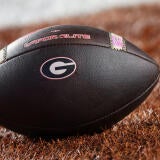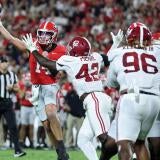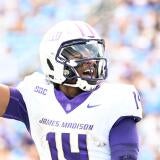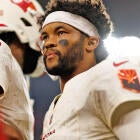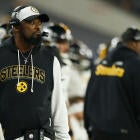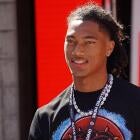Mobile quarterbacks taking over the Big Ten
The Big Ten's offensive identity is changing from a bruising running game to a more elusive, scrambling style. Led by Michigan's Denard Robinson, the majority of the league's teams now feature a duel-threat QB.
The Big Ten is having an identity crisis. It used to be thought of as a predominantly ground-and-pound type league featuring burly running backs banging through defensive lines. That’s no longer the case. Instead, most Big Ten offenses revolve around fleet-footed quarterbacks who are able to scramble out of collapsing pockets and create something from nothing.
Five Big Ten QBs – Denard Robinson, Braxton Miller, MarQueis Gray, Nathan Scheelhaase, and Kain Colter – led their team in rushing last season. Two more – Taylor Martinez and Tre Roberson – were their team’s second leading rusher. Why has the conference seen such a proliferation of dual-threat quarterbacks?
“It’s a different speed. It’s changing. Football’s changing. I see more guys trying to move around in the pocket now, more guys trying to get faster with their footwork,”Michigan’s Denard Robinson said.
Robinson, the league’s most dynamic hybrid quarterback, rushed for 1,176 yards and 16 touchdowns last season. Only four Big Ten running backs (Montee Ball, Rex Burkhead, Silas Redd, Marcus Coker) ran for more yards than Robinson.
Robinson's decision came down to Michigan and Florida after Urban Meyer offered him a scholarship, but the Florida native ultimately chose the Wolverines. Robinson would’ve shined in Meyer’s spread offense, much like current Buckeye QB Braxton Miller is expected to this season.
Meyer’s offense, which incorporates an SEC flavor, spreads the defense out wide and then attacks the gaps with his most elusive players. His dynamic sophomore Braxton Miller threw for 13 touchdowns and rushed for seven more. Miller also had three games of more than 100 yards rushing last year.
“I think it was eight out of the 12 teams are running some sort of spread offense right now and then there’s two option offenses, and that’s obviously a drastic change from historically what you think of the Big Ten,” Meyer said. The Ohio native plans to use Miller in much the same way he used Tim Tebow.
Not only does a scrambling quarterback who’s able to elude the pass rush buy time for receivers, but it keeps the defense guessing and forces linebackers out of pass coverage.
“It’s about playing a disciplined defense,” Michigan State linebacker Max Bullough said, referring to Robinson. “That’s gonna breaks down it’s about hustling and keeping the damage to a minimum right after he breaks a five yard run instead of a 25 yard run.”
Iowa’s James Vandenberg is one of the few strictly pro-style quarterbacks in the Big Ten. Vandenberg’s 3,022 yards passing were third to Michigan State’s Kirk Cousins and Wisconsin’s Russell Wilson, both now in the NFL.
“It’s just a sign of the times,” Iowa coach Kirk Ferentz said at Big Ten media days. “The read option stuff’s become bigger and bigger. It shifts this way and shifts that way. There’s no magical way to do things,” he said.
Minnesota QB MarQueis Gray is in a unique position as the dual-threat signal caller of the Golden Gophers. His team lacks the playmakers of Ohio State or Michigan which makes his scrambling ability even more of an asset.
“If you don’t have a mobile quarterbacks and something breaks down, then they’re not going to go and get that extra yard for you,” Gray said. “Every year people are getting bigger, faster, stronger, you don’t want a quarterback who’s fast just to go and sit back there. You want that guy to go out and make plays for you.”
It’s no surprise that Iowa’s Ferentz, an old-school coach and proponent of passing quarterbacks, only cares about the result.
“There’s always typically a flavor of the day but at the end of the day, it all comes down to execution,” he said.
For more Big Ten coverage, follow Mike Singer and Dave Carey @CBSSportsBigTen.



